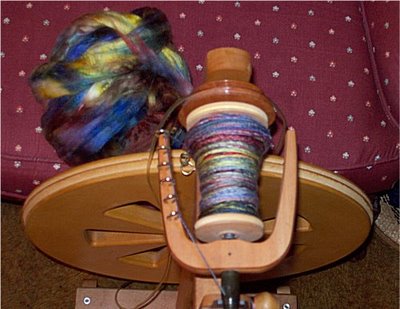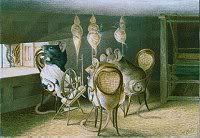 Lent, a time for repentance, reflection, discipline and setting priorities, to list a few treasures of this season, so if the posting drops off a bit you will understand that I am trying to put these into practice. Still I have said it before, fibre art is very spiritual and I can manage to contemplate what this time of year means for me and my relationship with our Creator while spinning, weaving, knitting. In point of fact these activities help me realize how blessed I am.
Lent, a time for repentance, reflection, discipline and setting priorities, to list a few treasures of this season, so if the posting drops off a bit you will understand that I am trying to put these into practice. Still I have said it before, fibre art is very spiritual and I can manage to contemplate what this time of year means for me and my relationship with our Creator while spinning, weaving, knitting. In point of fact these activities help me realize how blessed I am.
Right now I have several projects going on, if you have been following my posts you probably have already noticed, and may even be thinking...."Pick a project and follow it through". There is a method to the madness though. I am trying to work out what to bring to the project. What tools work best with which fibre for the desired end results. This is a little more difficult than it sounds, or at least for me it is.
So lets address spinning. I am in the process of spinning lace weight and currently have a bobbin of mohair, merino and corn. Yes believe it or not you can spin corn. I am still not entirely clear on the process but here is a picture of some commercially processes and dyed corn. I am told it is not the silky fibres you see covering the cob itself, that was my guess.
I was pleasantly surprised to find it so easy to spin. And interestingly enough it is turning out to look and even feel very similar to some silk I spun recently. The test, of course, will be how well it knits or weaves.
The reason for spinning a variety of fibres is, of course, to see how each responds to spinning lace weight. Which holds up better, spinning tight enough without pigtails and stays soft, since a little tighter twist is indicated the yarn can end up with something on the rough side. I also want to take note of each fibre's charictaristic. Which fibre is more elastic, which will still display it's luster at that weight and which is lighter, the weight determining which will drape better.
Labels: natural fibres
 I started out using what is becoming one of my favorite brand of needles, Bryspun, on the Orenburg Shawl pattern. It called for 2mm or smaller. Since I had nothing that small I had to order them, needles that small are usually metal because wood and/or plastic will break easily at that gauge. I had pulled away from using metal needles some years ago and it is becoming evident why with every stitch. Beside being cold, hard and unfriendly, which makes them very uncomfortable to work with, the stitches slip off the tips so readily. Still I am determined to keep working with them in hopes to become more proficient and eventually,.....perhaps....dare I hope to adapt. Somehow I suspect, however, frustration will rear it's ugly head before that happens and convince me to end up modifying patterns to allow a little larger Bryspun.
I started out using what is becoming one of my favorite brand of needles, Bryspun, on the Orenburg Shawl pattern. It called for 2mm or smaller. Since I had nothing that small I had to order them, needles that small are usually metal because wood and/or plastic will break easily at that gauge. I had pulled away from using metal needles some years ago and it is becoming evident why with every stitch. Beside being cold, hard and unfriendly, which makes them very uncomfortable to work with, the stitches slip off the tips so readily. Still I am determined to keep working with them in hopes to become more proficient and eventually,.....perhaps....dare I hope to adapt. Somehow I suspect, however, frustration will rear it's ugly head before that happens and convince me to end up modifying patterns to allow a little larger Bryspun.



 Melangell
Melangell












